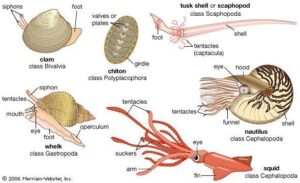Back to: ZOOLOGY 200 Level
I’m thrilled to see you back and ready to dive into another fascinating topic. Today, we’ll be looking at three diverse and important types of molluscs: gastropods, bivalves, and cephalopods. Let’s explore what makes each group unique and how they live in the world around us.
Gastropods, Bivalves, Cephalopods
Gastropods
Gastropods are the largest group of molluscs, and they include snails, slugs, and limpets. The word “gastropod” comes from the Greek words gastro (stomach) and pod (foot), which reflects their body structure.

Gastropods have a single, often coiled shell, although some, like slugs, lack shells altogether. The body is divided into the head-foot (for movement and feeding) and the visceral mass (containing internal organs). They move using a muscular foot that glides along a slimy trail of mucus, which reduces friction and helps them travel over rough surfaces.
Gastropods are highly adaptable and can be found in diverse habitats—from marine environments to freshwater ponds and even on land. Some, like the african giant land snail, are famous for their large size and have economic importance in some African countries. Many gastropods are herbivores, feeding on plants and algae, while others are carnivores, preying on smaller invertebrates.
Bivalves
Bivalves include species like clams, oysters, mussels, and scallops. As the name suggests, bivalves have two shells (valves) that protect their soft bodies. These shells are hinged together and can open and close.
Bivalves have a simple body plan: the soft body inside the shell consists of the foot, which is used for burrowing, and the visceral mass containing internal organs. Unlike gastropods, bivalves do not have a head or a radula. Instead, they use gills for filter feeding, drawing in water, and trapping tiny particles of food.
Bivalves are usually aquatic and are found in both saltwater and freshwater. They are important for ecosystems because they filter large amounts of water, improving water quality. Clams and oysters, for instance, help keep the water clean by removing plankton and organic debris. Many bivalves are also commercially valuable as food.
Cephalopods
Cephalopods are the most advanced and complex group of molluscs. They include animals like squids, octopuses, cuttlefish, and nautiluses. The name cephalopod comes from the Greek words kephale (head) and pod (foot), referring to the fact that their feet are modified into tentacles that surround the head.
Unlike gastropods and bivalves, cephalopods do not have an external shell (though the nautilus does). Instead, they have a soft, muscular body that allows them to move swiftly through the water. They are famous for their ability to squirt ink, a defence mechanism that helps them escape predators.

Cephalopods are carnivores and are well-adapted for hunting, with highly developed eyes, complex nervous systems, and an ability to change colour and texture for camouflage. Squids and octopuses are agile swimmers and hunters, using jet propulsion to move through the water quickly.
Summary
Gastropods, bivalves, and cephalopods are three distinct groups of molluscs. Gastropods include snails and slugs and are known for their single shell (or lack of one), while bivalves like clams and oysters have two shells and filter feed. Cephalopods, the most complex of the three, include squids and octopuses and are adapted for active hunting and swift movement in the water.
Evaluation
- What is the main feature that distinguishes gastropods from bivalves?
- How do bivalves feed and what role do they play in their environment?
- Describe the unique features of cephalopods that make them different from other molluscs.
- Give an example of a mollusc that is important to humans for food.
You’ve made great strides today in learning about the diversity of molluscs and how they’re adapted to their environments. Remember, every new piece of knowledge builds your scientific understanding. Keep going, and Afrilearn will continue to be here to support you!
